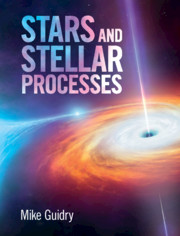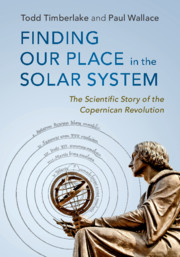Refine listing
Actions for selected content:
17002 results
2 - Two spheres: modeling the heavens and the Earth
-
- Book:
- Finding our Place in the Solar System
- Published online:
- 18 March 2019
- Print publication:
- 28 March 2019, pp 13-48
-
- Chapter
- Export citation
1 - Introduction: mysterious skies
-
- Book:
- Finding our Place in the Solar System
- Published online:
- 18 March 2019
- Print publication:
- 28 March 2019, pp 1-12
-
- Chapter
- Export citation
7 - Physical causes: Kepler’s new astronomy
-
- Book:
- Finding our Place in the Solar System
- Published online:
- 18 March 2019
- Print publication:
- 28 March 2019, pp 175-210
-
- Chapter
- Export citation
Notes
-
- Book:
- Finding our Place in the Solar System
- Published online:
- 18 March 2019
- Print publication:
- 28 March 2019, pp 337-354
-
- Chapter
- Export citation
Contents
-
- Book:
- Finding our Place in the Solar System
- Published online:
- 18 March 2019
- Print publication:
- 28 March 2019, pp vii-x
-
- Chapter
- Export citation
9 - The system of the world: Newton’s universal physics
-
- Book:
- Finding our Place in the Solar System
- Published online:
- 18 March 2019
- Print publication:
- 28 March 2019, pp 247-280
-
- Chapter
- Export citation
6 - Instruments of reform: Tycho’s restoration of observational
-
- Book:
- Finding our Place in the Solar System
- Published online:
- 18 March 2019
- Print publication:
- 28 March 2019, pp 147-174
-
- Chapter
- Export citation
5 - Moving the Earth: the revolutions of Copernicus
-
- Book:
- Finding our Place in the Solar System
- Published online:
- 18 March 2019
- Print publication:
- 28 March 2019, pp 107-146
-
- Chapter
- Export citation
Index
-
- Book:
- Finding our Place in the Solar System
- Published online:
- 18 March 2019
- Print publication:
- 28 March 2019, pp 365-378
-
- Chapter
- Export citation
Frontmatter
-
- Book:
- Finding our Place in the Solar System
- Published online:
- 18 March 2019
- Print publication:
- 28 March 2019, pp i-iv
-
- Chapter
- Export citation
8 - Seeing beyond Aristotle: Galileo’s controversies
-
- Book:
- Finding our Place in the Solar System
- Published online:
- 18 March 2019
- Print publication:
- 28 March 2019, pp 211-246
-
- Chapter
- Export citation

Stars and Stellar Processes
-
- Published online:
- 21 March 2019
- Print publication:
- 07 February 2019
-
- Textbook
- Export citation

Finding our Place in the Solar System
- The Scientific Story of the Copernican Revolution
-
- Published online:
- 18 March 2019
- Print publication:
- 28 March 2019
7 - Spectroscopic Methods to Study Planetary Atmospheres
-
- Book:
- Spectroscopy and Photochemistry of Planetary Atmospheres and Ionospheres
- Published online:
- 09 February 2019
- Print publication:
- 14 February 2019, pp 86-102
-
- Chapter
- Export citation
Contents
-
- Book:
- Spectroscopy and Photochemistry of Planetary Atmospheres and Ionospheres
- Published online:
- 09 February 2019
- Print publication:
- 14 February 2019, pp vii-xii
-
- Chapter
- Export citation
6 - Spectrographs
-
- Book:
- Spectroscopy and Photochemistry of Planetary Atmospheres and Ionospheres
- Published online:
- 09 February 2019
- Print publication:
- 14 February 2019, pp 78-85
-
- Chapter
- Export citation
15 - Pluto and Charon
-
- Book:
- Spectroscopy and Photochemistry of Planetary Atmospheres and Ionospheres
- Published online:
- 09 February 2019
- Print publication:
- 14 February 2019, pp 467-496
-
- Chapter
- Export citation
1 - The Solar System
-
- Book:
- Spectroscopy and Photochemistry of Planetary Atmospheres and Ionospheres
- Published online:
- 09 February 2019
- Print publication:
- 14 February 2019, pp 1-10
-
- Chapter
- Export citation
13 - Titan
-
- Book:
- Spectroscopy and Photochemistry of Planetary Atmospheres and Ionospheres
- Published online:
- 09 February 2019
- Print publication:
- 14 February 2019, pp 367-442
-
- Chapter
- Export citation
2 - Atmospheric Structure
-
- Book:
- Spectroscopy and Photochemistry of Planetary Atmospheres and Ionospheres
- Published online:
- 09 February 2019
- Print publication:
- 14 February 2019, pp 11-29
-
- Chapter
- Export citation
